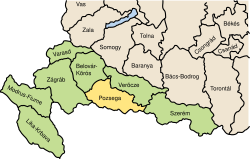Pozsega (former county)
| Požega County Požeška županija Pozsega vármegye |
|||||
| County of the Kingdom of Croatia-Slavonia | |||||
|
|||||
|
Coat of arms |
|||||
| Location of the County (yellow) within the Kingdom of Croatia-Slavonia (green) | |||||
| Capital |
Požega 45°20′N 17°41′E / 45.333°N 17.683°ECoordinates: 45°20′N 17°41′E / 45.333°N 17.683°E |
||||
| History | |||||
| • | Established | 12th century | |||
| • | Treaty of Trianon | 4 June 1920 | |||
| Area | |||||
| • | 1910 | 4,933 km2(1,905 sq mi) | |||
| Population | |||||
| • | 1910 | 265,272 | |||
| Density | 53.8 /km2 (139.3 /sq mi) | ||||
| Today part of | Croatia | ||||
Coat of arms
Požega County (Croatian: Požeška županija; Hungarian: Pozsega vármegye) was a historic administrative subdivision (županija) of the Kingdom of Croatia-Slavonia. Croatia-Slavonia was an autonomous kingdom within the Lands of the Crown of Saint Stephen (Transleithania), the Hungarian part of the dual Austro-Hungarian Empire. Its territory is now in eastern Croatia. The capital of the county was Požega (Croatian, in Hungarian: Pozsega).
Požega county shared borders with the Austrian land Bosnia-Herzegovina and the counties of Zagreb, Bjelovar-Križevci, Virovitica and Srijem (all in Croatia-Slavonia). The county stretched along the left (northern) bank of the river Sava. Its area was 4933 km² around 1910.
...
Wikipedia


